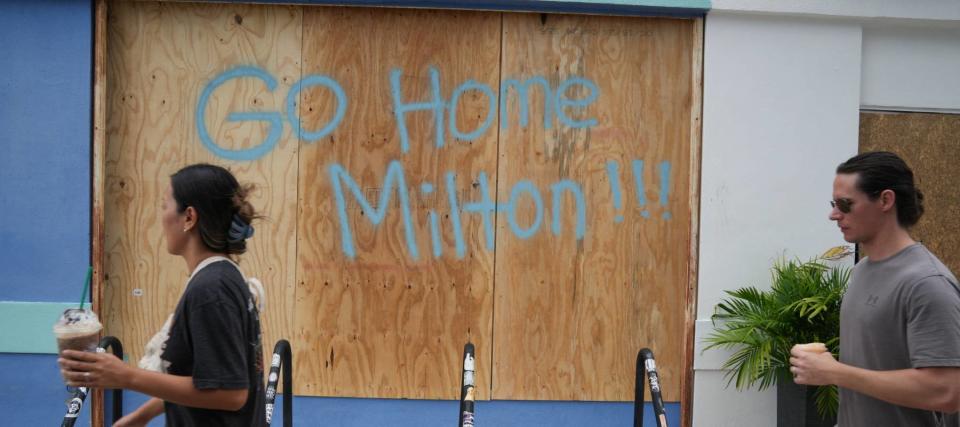An NC man's house floated away during Hurricane Helene, and insurance won’t help. Milton could bring more of the same

Hurricane Milton, a Category 5 storm in the Gulf of Mexico, is due to make what many are predicting will be a catastrophic landfall on the west coast of Florida later today.
The new storm comes mere weeks after Hurricane Helene beat its destructive path.
Don't miss
Car insurance premiums in America are through the roof — and only getting worse. But 5 minutes could have you paying as little as $29/month
Lock in juicy quarterly income through this $1B private real estate fund — even if you’re not a millionaire. Here’s how to get started with as little as $10
5 minutes could get you up to $2M in life insurance coverage — with no medical exam or blood test
Vlado Novakovic watched his three homes in Newland, North Carolina, get washed away in the early-October floods caused by Helene, a video shared with FOX Weather shows.
In the original video on Facebook, Novakovic shared his gratitude, in his native Croatian, for what he still had left.
“I’m alive,” Novakovic captioned the video, which shows houses disappearing down a rushing river.
Insurance will not cover Novakovic’s losses, he confirmed in the comments of the Facebook video,
The heartbreaking scene is just a sliver of the devastation to hit southern and central Appalachia, where at least 170 people have died — and what many predict will befall west-central Florida when Milton hits.
As many as 32 people were airlifted out of Avery County, where Novakovic used to live, by the local sheriff and 20 deputies, a post on Facebook shows.
The disaster response has included FEMA and the North Carolina National Guard delivering supplies and searching for missing residents.
But when the winds slow and the rain dissipates, a secondary insurance response won’t cover most of the people left homeless by the storm.
Most flooded homes aren’t covered
Helene is expected to cause $25 billion to $30 billion in physical damage, and most of that won’t get compensated by insurance companies, one disaster modeler told Bloomberg.
Milton could cause as much as $175 billion in damage, according to Wall Street analysts.
Regular home insurance does not protect against flooding, and only homeowners living in FEMA-designated flood zones are required to buy flood insurance. The Tampa area, which is expected to bear the brunt of Milton this week, is within the FEMA borders.
About 4% of American homeowners have flood insurance, and that’s mostly under the federal government’s National Flood Insurance Program.
Wind versus water
Not all hurricanes are made equal, however.
In 2022, insurers paid out $63 billion to victims of Hurricane Ian, because most of the damage was from the impacts of wind, which is covered by traditional home insurance, a risk modeler told Bloomberg.
But only a few years earlier, when Hurricane Florence hit the Carolinas, insurance companies mostly avoided paying the people who lost their homes because the damage was largely flood-related, Insurance Journal reported.
Helene is looking like a repeat of Florence in terms of insurance coverage, and the uninsured will pay the price, Jeff Waters, an analyst at Moody's Analytics subsidiary RMS, told ABC News.
Read more: These 5 magic money moves will boost you up America's net worth ladder in 2024 — and you can complete each step within minutes.
Why insurance is so expensive
The rising cost of insurance is deterring many Americans from taking up a flood policy, experts told ABC News.
Hurricane-path states Florida, Georgia, South Carolina, North Carolina, Kentucky, Tennessee and Virgini saw their insurance premiums rise dramatically between 2018 and 2023.
That increase in rates matched the rising frequency of severe climate disasters in the U.S., and the amount insurance companies paid tripled over the same time frame, according to Deloitte.
Both the increase in natural disasters and the rising costs of building materials have contributed to the spike in insurance premiums, experts told ABC News.
If your home suffers damage from one of the year’s big hurricanes , there’s a good chance your home insurance premiums will go up significantly.
“There’s no question that the burden on households’ budgets has increased in recent years,” Benjamin Keys, a professor of real estate at the University of Pennsylvania told ABC News.
“It has gotten substantially more expensive to live in harm’s way.”
Find flood insurance before the storm
You can buy NFIP coverage from insurance companies, which all use the same government pricing structure, based on where you live and how at risk your property is.
Amica, Farmers and Nationwide are the biggest sellers of the program’s policy, according to CNBC.
The program covers up to $250,000 in structural damage and up to $100,000 in personal possessions.
If you want a higher coverage rate, you’ll have to go with a private policy,
Aon and Beyond Floods offer over $1 million in structural damage and between $750,000 and $875,000 in personal contents
Meanwhile, Chubb offers coverage for high-value homes, which tops out at $15 million for structural damage and lost possessions combined.
What to read next
Medical debt is the leading cause of bankruptcy in America — just 3 minutes could protect you from disaster
Baby boomers bust': Robert Kiyosaki warns that older Americans will get crushed in the 'biggest bubble in history' — 3 shockproof assets for instant insurance now
The price of home insurance has skyrocketed to an average of $2,285 a year. But smart homeowners can save up to $980 a year – here’s how
This article provides information only and should not be construed as advice. It is provided without warranty of any kind.